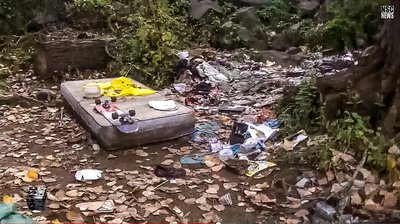
At first glance, it looks like a landfill — abandoned couches and chairs, food wrappers piled on top of plastic bags, electronics and old clothing. But in actuality, it’s a strip of riverbank along the south side of the Willamette River between Autzen Footbridge and Knickerbocker Bike Bridge, and a recent YouTube video portraying trash along the riparian zone has garnered the attention of homeless activists, environmentalists and Eugene Mayor Kitty Piercy.
“Soon the high waters are coming, and all of that garbage is going to be washed into the water,” says Aaron Baker, who shot the video and posted it to his No Sugar Coated News YouTube channel Nov. 8 after seeing tents from the bike path. “It’s an extreme amount of garbage, and it’s definitely below the high-water mark.”
The video revived conversations about the rights of the homeless to sleep and exist, and how people pushed out of the city are forced to find other places to live. For some, that means the riverbank.
On Facebook, Piercy responded to the video, saying that it isn’t city land and is either railroad or UO property and that the Eugene parks department would contact property owners “to try to get this tended to.” In over 90 comments to her remark, posters have debated over who should take care of the trash and how the issue only highlights the limited options available to the homeless when it comes to camping.
The site in the video belongs to Union Pacific, according to Matt Roberts, senior director of community relations for the UO. “The UO, the city and Union Pacific are working in collaboration to try and address the issue from a bigger perspective,” Roberts says.
John Brown, an EWEB board member with years of experience cleaning up riverbanks, says that the site is the worst he’s ever seen it. “In an earlier cleanup of a 300-yard strip, HIV Alliance found 1,100 hypodermic needles,” Brown says. “It’s a sad thing to have happen to a protected waterway.”
Brown says he’s spoken repeatedly to the Eugene City Council and Piercy about this issue, and he says he worries that once grocery carts, foam pads and tents get swept into the water, they will be difficult if not impossible to retrieve.
“Water’s the most precious resource we’ve got,” he says.
Travis Williams, executive director of Willamette Riverkeeper, says that while the video reflects “the kind of trash we don’t want heading into the Willamette when the water level gets up,” the video also highlights a wider societal issue.
He adds that the city of Portland provides Porta-Potties to areas along the river where people camp, and it helps prevent human waste from entering the water stream.
Michelle Emmons, also of Willamette Riverkeeper, says she’s worked locally to educate the public on this issue. She says volunteer work is restricted in certain areas due to the hazardous nature of the materials concerned, including human waste and used needles. “This isn’t about villainizing people who are homeless or have drug addiction,” she says. “One suggestion has been the installation of Dumpsters. What if we provided some way for people to be more responsible?”
Roberts says that since Union Pacific is such a large organization, it takes time to implement actions like local cleanups. UP spokesman Mark Davis says the area was cleaned earlier this year, and the railroad is working with local stakeholders on a solution to keep people from “putting themselves in an unsafe position” to “access the areas that are requiring cleanup.” See the video at wkly.ws/1uf.